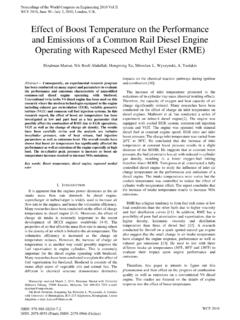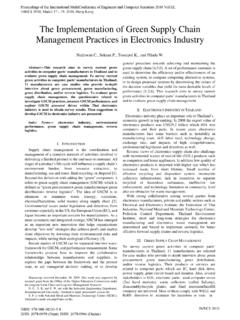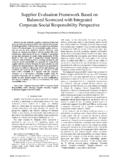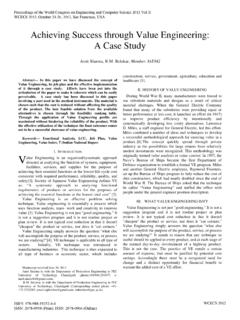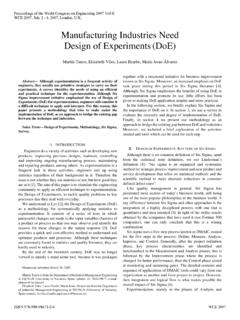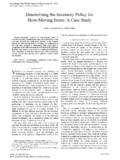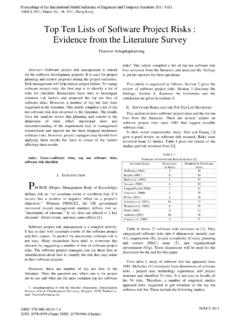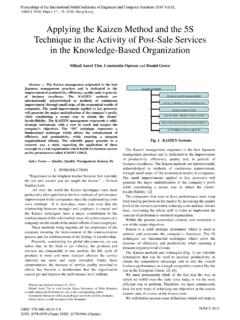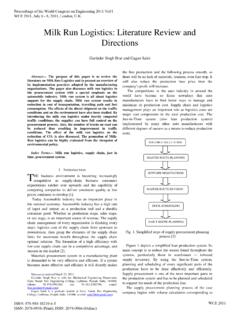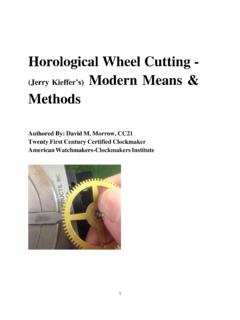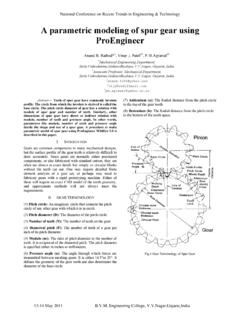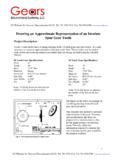Transcription of Tolerance Analysis of Involute Splines - IAENG
1 Abstract The authors present the Analysis of the Tolerance system of Involute Splines . They explain the concept of effective variation, actual and effective tooth size. The Analysis of the effective variation, which is defined as the deviation allowance, for the different spline Tolerance classes is presented. Pitch diameter is assumed as a reference parameter during the Analysis . Index Terms effective variation, form deviation, Involute spline I. INTRODUCTION spline is defined as an equally spaced, multi-toothed connector, which is used to transmit rotary motion from an input to an output and to align two mating elements.
2 Splined connections are applied to couple elements and transfer torque from splined shaft to splined hub or to other rotary component such as gear, pulley, flywheel, or the like (fig. 1). These connections can be found in mechanical transmission systems, gas turbine engine mainshaft, intermediate shaft of tractor gearbox, and automobile drive shaft. Splined connections are made in two types: straight-sided and Involute profile. The Involute spline is stronger, due to the gradual increase of tooth thickness and less stress concentration factor (about times less), than straight- Manuscript received March 08, 2011; revised March 28, 2011.
3 Jacek Kroczak is with the Chair of Basics of Machine Design, Poznan University of Technology, 60-965 Poznan, Poland (corresponding author, phone: +48-61-665-2042; fax: +48-61-665-2074; e-mail: Marian Dudziak is with the Chair of Basics of Machine Design, Poznan University of Technology, 60-965 Poznan, Poland (e-mail: sided spline [6]. Further, the Involute Splines guarantee self-centering action of hub and shaft which are being under load. There are two basics types of Splines : the flexible spline (working) and the fixed splined (nonworking).))
4 Flexible spline allows some rocking motion whereas fixed spline allows no relative or rocking motion between two coupling elements. Involute Splines are very similar to gears, but their teeth are shorter in height (a stub tooth). Therefore, an Involute spline can be cut and measured by the same machines as for gear teeth. Standard Involute Splines utilize the nominal pressure angle values of 300, or 450. However, in special applications, the pressure angles of , 200 or 250 are sometimes chosen, which are commonly used in gears. Involute Splines are specified by the international standard [4] or by the national standards, [1]-[3].
5 This paper considers the international standard only. According to the ISO standard there are four classes of machining Tolerance for Splines (4, 5, 6, 7) and six fit classes (H/d, H/e, H/f, H/h, H/js, H/k). Fittings mentioned above concern side fits only. Tooth flanks transmit the torque and simultaneously create the coaxial connection. II. ACTUAL AND EFFECTIVE TOOTH SIZE After machining and heat treatment of Involute Splines , one can not obtain a perfect Involute spline . There will always be some form deviations. These form deviations affect the maximum material condition and hence the fit of connection.
6 The form deviations are complex and occur on each flank of space and tooth. The most important spline deviations are: pitch deviation, profile deviation, and lead deviation. Therefore, the Tolerance system of Involute Splines must take into consideration the influence of existing form deviations on the clearance for the different accuracy classes. In order to consider a proper fit of assembly of two mating parts, there are two different dimensions for tooth thickness and space width. The first one is called the actual (real) tooth thickness (Smax, Smin) and it is just the circular thickness of tooth.
7 The second one is the effective tooth thickness (Svmax, Svmin) and it is equal to the circular space width on the pitch circle of an imaginary perfect internal spline which would fit the external spline without looseness or interference. The effective tooth thickness includes the actual tooth thickness and the variations of tooth form. The effective dimension controls the clearance, while the actual dimension determines the strength of the tooth [5]. Fig. 2 and 3 illustrate the relationship between these two dimensions. Tolerance Analysis of Involute Splines Jacek Kroczak, Marian Dudziak A Fig.
8 1. View of splined connection Proceedings of the World Congress on Engineering 2011 Vol III WCE 2011, July 6 - 8, 2011, London, : 978-988-19251-5-2 ISSN: 2078-0958 (Print); ISSN: 2078-0966 (Online)WCE 2011 The difference between the effective space width and the effective tooth thickness is equal to the effective clearance and defines the fit of the mating parts. The assembly of two Splines is controlled by the minimum effective clearance with the maximum effective tooth thickness and the minimum effective space width, and by the maximum clearance with the minimum actual tooth thickness and the maximum actual space width.
9 Hence, the effective size is used to determine if two parts will fit together at assembly. III. EFFECTIVE VARIATION AND FORM DEVIATION The effective variation is defined as the deviation allowance . This deviation is the accumulation of the total pitch deviation Fp, total profile deviation F , and total lead deviation F and has an effect on the effective fit of an Involute spline . The deviation allowance is calculated as follows: FFFp (1) Three types of form deviations are added together statistically and 60 percent of this total value is defined as deviation allowance.
10 The effect of individual spline deviations on the fit is less than their total, because areas of more than minimum clearance can be resized without changing the fit [4]. Formulas for allowable total form deviations are given in table I. These relationships are restricted to the following assumption: the length of engagement is equal to one half of the pitch diameter. Adjustments may be required for other lengths of engagement than assumed one. On the basis of the above mentioned relationships, the Analysis of the deviation allowance for the different spline Tolerance classes is conducted.
